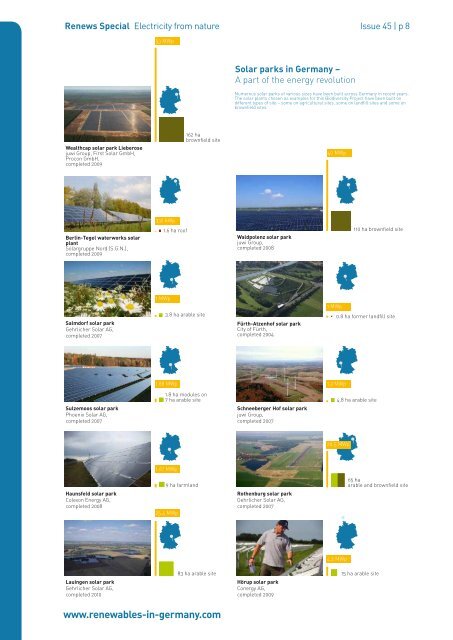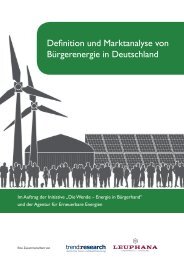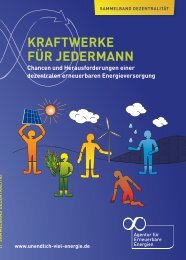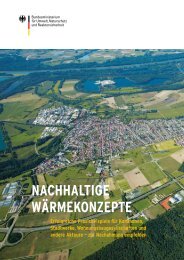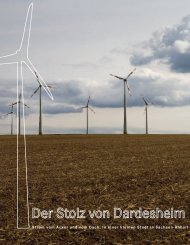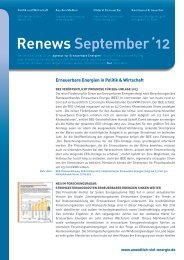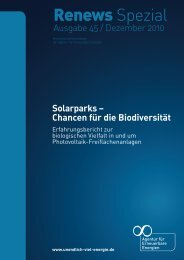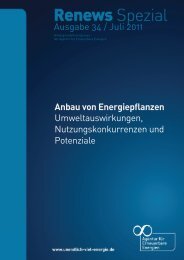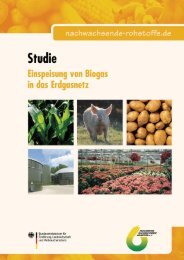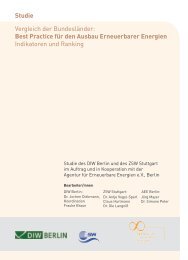Solar parks - Agentur für Erneuerbare Energien
Solar parks - Agentur für Erneuerbare Energien
Solar parks - Agentur für Erneuerbare Energien
You also want an ePaper? Increase the reach of your titles
YUMPU automatically turns print PDFs into web optimized ePapers that Google loves.
Renews Special Electricity from nature Issue 45 | p 8<br />
Wealthcap solar park Lieberose<br />
juwi Group, First <strong>Solar</strong> GmbH,<br />
Procon GmbH,<br />
completed 2009<br />
Berlin-Tegel waterworks solar<br />
plant<br />
<strong>Solar</strong>gruppe Nord (S.G.N.),<br />
completed 2009<br />
Salmdorf solar park<br />
Gehrlicher <strong>Solar</strong> AG,<br />
completed 2007<br />
Sulzemoos solar park<br />
Phoenix <strong>Solar</strong> AG,<br />
completed 2007<br />
Haunsfeld solar park<br />
Colexon Energy AG,<br />
completed 2008<br />
Lauingen solar park<br />
Gehrlicher <strong>Solar</strong> AG,<br />
completed 2010<br />
53 MWp<br />
332 kWp<br />
1 MWp<br />
1.6 ha roof<br />
3.8 ha arable site<br />
1.88 MWp<br />
162 ha<br />
brownfield site<br />
1.8 ha modules on<br />
7 ha arable site<br />
1.67 MWp<br />
9 ha farmland<br />
25.4 MWp<br />
83 ha arable site<br />
<strong>Solar</strong> <strong>parks</strong> in Germany –<br />
A part of the energy revolution<br />
Numerous solar <strong>parks</strong> of various sizes have been built across Germany in recent years.<br />
The solar plants chosen as examples for this Biodiversity Project have been built on<br />
different types of site – some on agricultural sites, some on landfill sites and some on<br />
brownfield sites.<br />
Waldpolenz solar park<br />
juwi Group,<br />
completed 2008<br />
Fürth-Atzenhof solar park<br />
City of Fürth,<br />
completed 2004<br />
Schneeberger Hof solar park<br />
juwi Group,<br />
completed 2007<br />
Rothenburg solar park<br />
Gehrlicher <strong>Solar</strong> AG,<br />
completed 2007<br />
Hörup solar park<br />
Conergy AG,<br />
completed 2009<br />
40 MWp<br />
1 MWp<br />
110 ha brownfield site<br />
0.8 ha former landfill site<br />
1.2 MWp<br />
4.8 ha arable site<br />
20.5 MWp<br />
4.2 MWp<br />
65 ha<br />
arable and brownfield site<br />
15 ha arable site<br />
p 9 | Issue 45 Renews Special <strong>Solar</strong> <strong>parks</strong> – Opportunities for Biodiversity<br />
1.2. <strong>Solar</strong> <strong>parks</strong> and land consumption in Germany<br />
Even with an ambitious expansion programme, by 2020, solar <strong>parks</strong> will occupy only 0.04 per cent of the total land area of Germany. (Photo: Gehrlicher <strong>Solar</strong> AG)<br />
The area of land used for agriculture in Germany is around 18.8 million hectares, accounting for<br />
approximately 53 per cent of Germany’s total land area. In view of the small area (far less than one per<br />
cent of the total land area) occupied by solar <strong>parks</strong>, there is no need to fear competition for land, as<br />
claimed in some quarters, even in the future. On the contrary, there are good opportunities for solar<br />
<strong>parks</strong> to improve the ecological value of land. Indeed, the intensification of agricultural land use has<br />
generally led to a severe decline in species diversity. <strong>Solar</strong> <strong>parks</strong> are relatively benign compared to<br />
intensive agricultural land use. The same goes for the conversion of sealed industrial sites into solar<br />
<strong>parks</strong>. The unsealing of these sites and the generally negligible amount of sealing required to support<br />
the solar modules, means that there is potential for considerable ecological improvement.<br />
<strong>Solar</strong> <strong>parks</strong> and other renewable energy technologies are included in the list of culprits in the debate<br />
about the 100 hectares of German land consumed per day for human settlement and transport. A look<br />
at the facts shows that, for ground-mounted solar plants at least, the proportion of land area used is<br />
comparatively tiny. If solar energy continues to expand to around 4 Gigawatts for ground mounted PV by<br />
2020, a total of around 10,500 - 14,000 hectares would be required for solar <strong>parks</strong>. This would represent<br />
no more than 0.04 per cent of Germany’s total land area. By contrast, land consumption for opencast<br />
lignite mines in 2008 was around 48,300 hectares. As well as releasing large quantities of carbon<br />
dioxide during electricity generation, open-cast lignite mining irreversibly ruins whole landscapes, with<br />
resulting negative ecological and social consequences. Remediation and restoration is very costly. <strong>Solar</strong><br />
plants do not change the landscape to the same extent and they can be dismantled and recycled.<br />
In summary, the area used by ground-mounted solar plants in Germany is comparatively small, and will<br />
remain so in the future, despite ambitious expansion targets.


